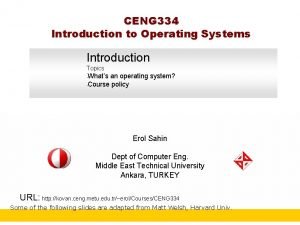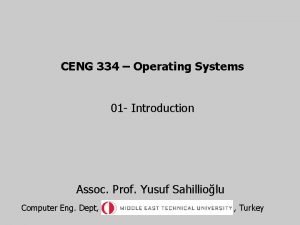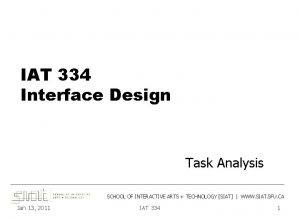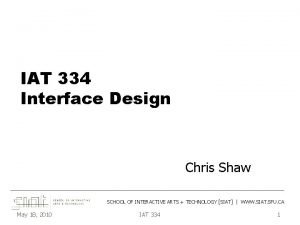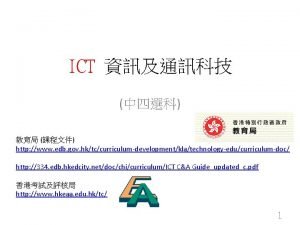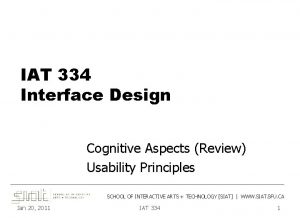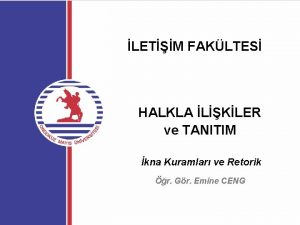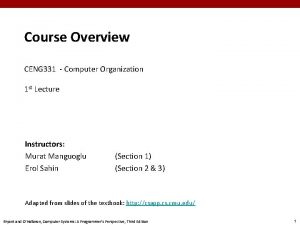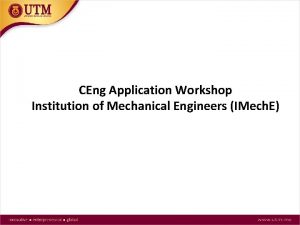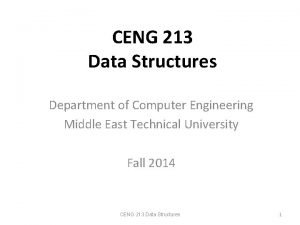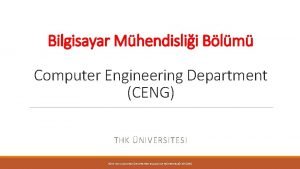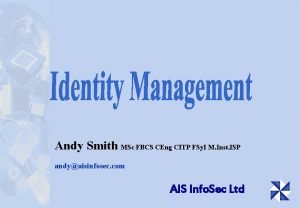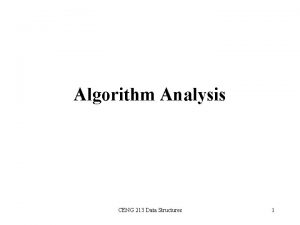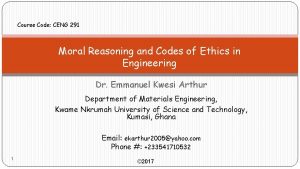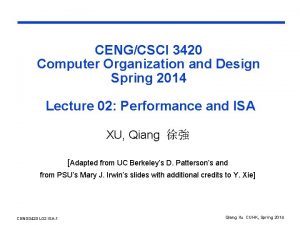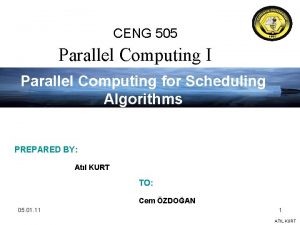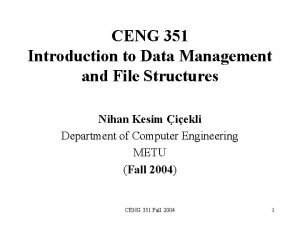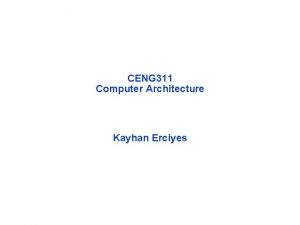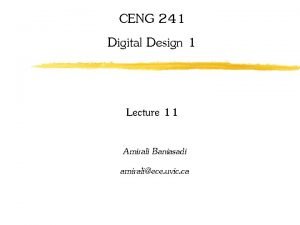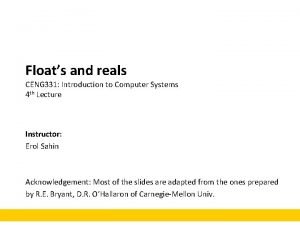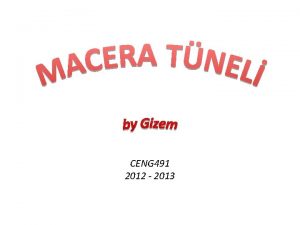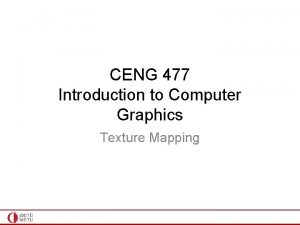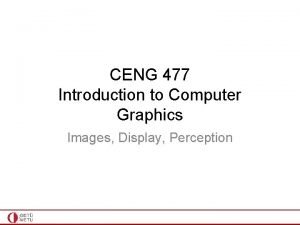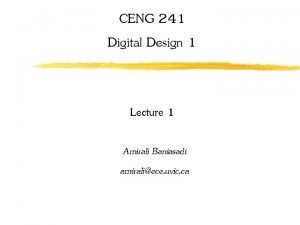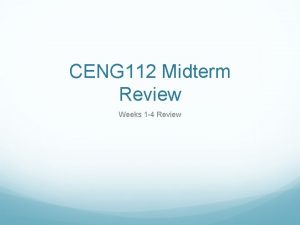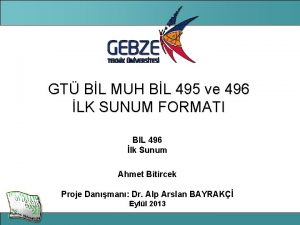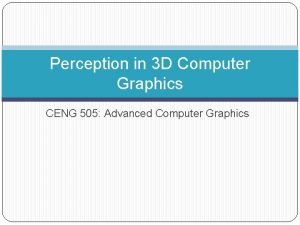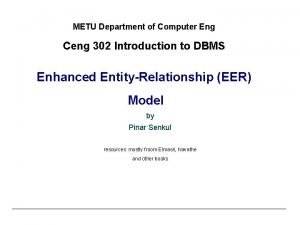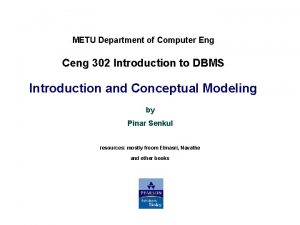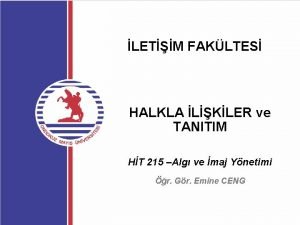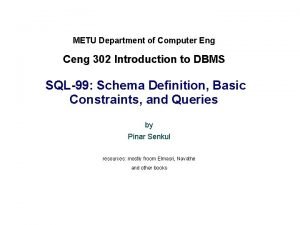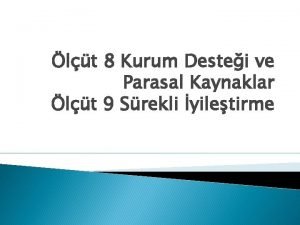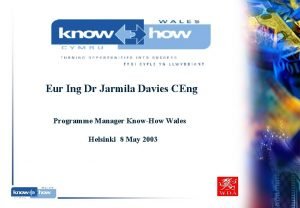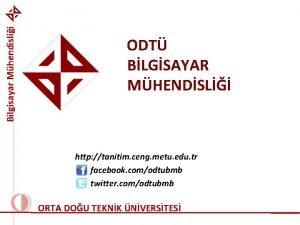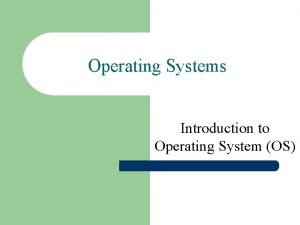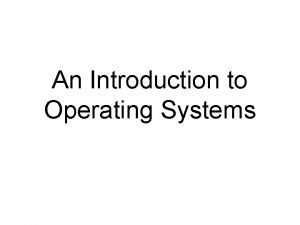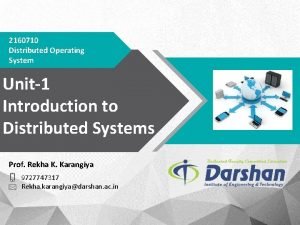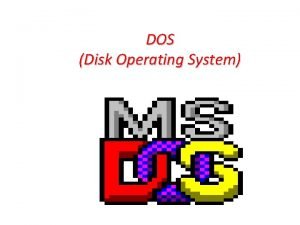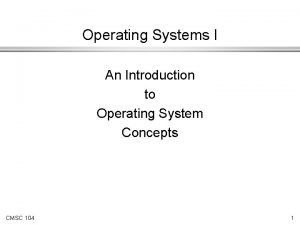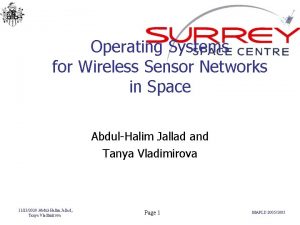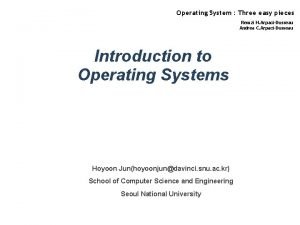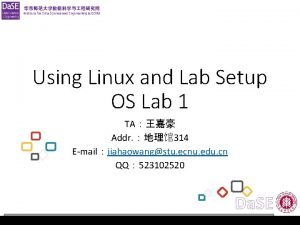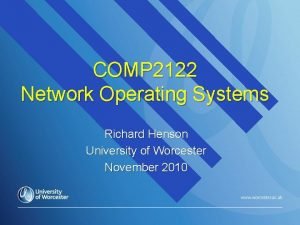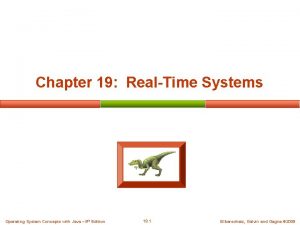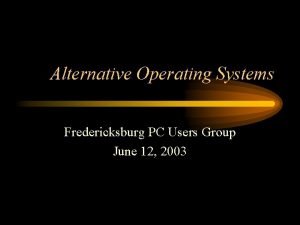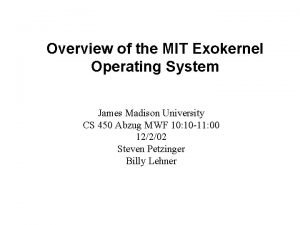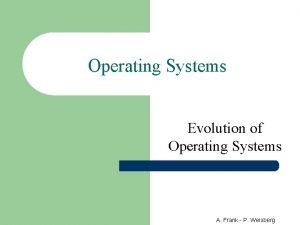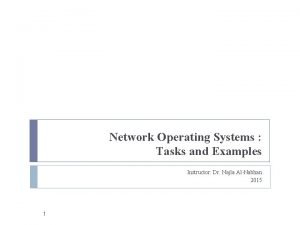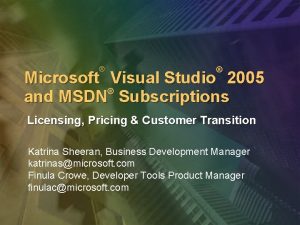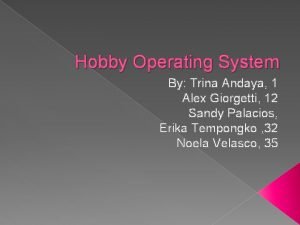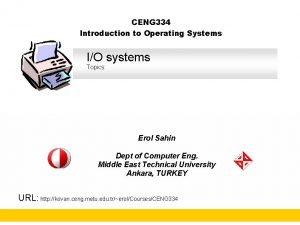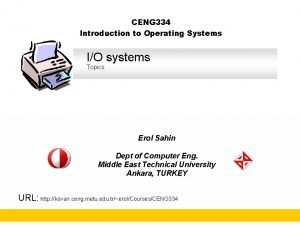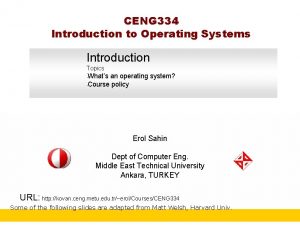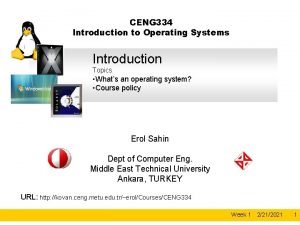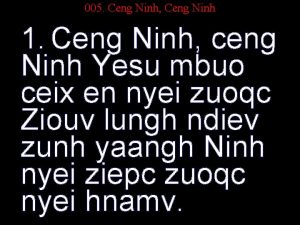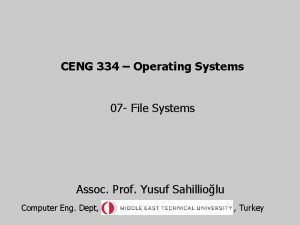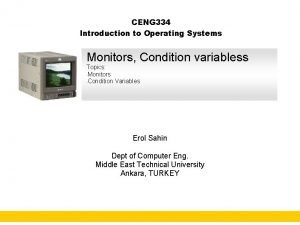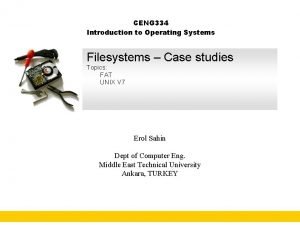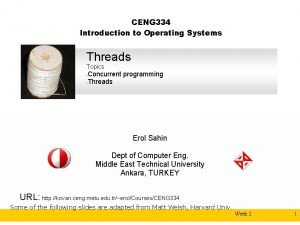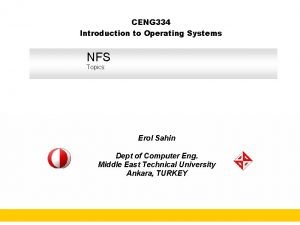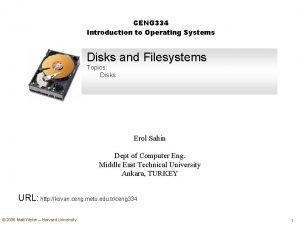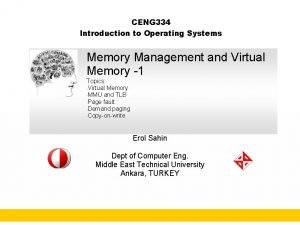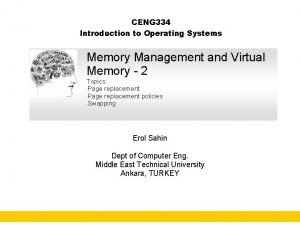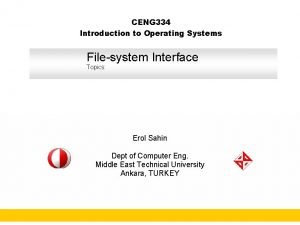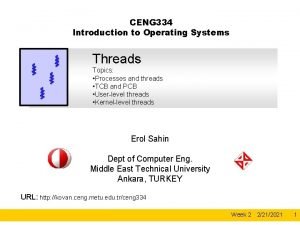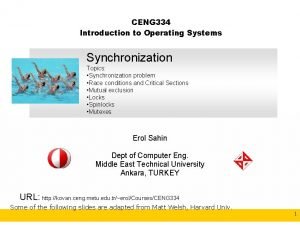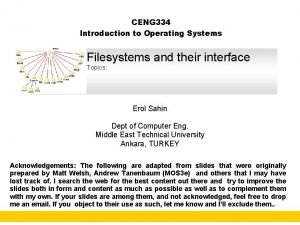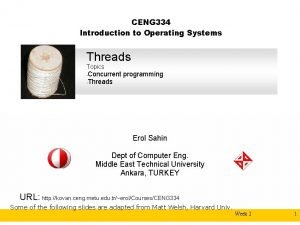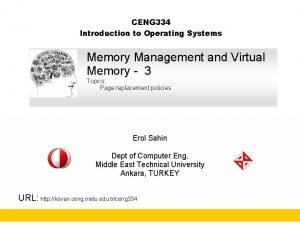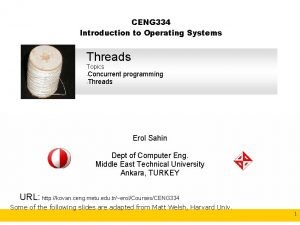CENG 334 Introduction to Operating Systems IO systems































































- Slides: 63

CENG 334 Introduction to Operating Systems I/O systems Topics: Erol Sahin Dept of Computer Eng. Middle East Technical University Ankara, TURKEY URL: http: //kovan. ceng. metu. edu. tr/ceng 334

I/O A computer without I/O support is more like a turkey who is claimed to think but not speak. . Hence, I/O is an essential part of an operating system. Similar to other aspects of a machine, the OS should abstract the gory details of I/O. There exist a wide variety of I/O devices, both in their types and characteristics. 2

Modern I/O Systems Slide from Kubiatowichz 3

I/O Devices In UNIX philosophy, the I/O devices are roughly divided into two Figure 5 -1. Some typical device, network, and bus data rates. Tanenbaum, Modern Operating Systems 3 e, (c) 2008 Prentice-Hall, Inc. All rights reserved. 0 -13 -6006639 4

Memory-Mapped I/O (1) Figure 5 -2. (a) Separate I/O and memory space. (b) Memory-mapped I/O. (c) Hybrid. Tanenbaum, Modern Operating Systems 3 e, (c) 2008 Prentice-Hall, Inc. All rights reserved. 0 -13 -6006639 5

Memory-Mapped I/O (2) Figure 5 -3. (a) A single-bus architecture. (b) A dual-bus memory architecture. Tanenbaum, Modern Operating Systems 3 e, (c) 2008 Prentice-Hall, Inc. All rights reserved. 0 -13 -6006639 6

Direct Memory Access (DMA) Figure 5 -4. Operation of a DMA transfer. Tanenbaum, Modern Operating Systems 3 e, (c) 2008 Prentice-Hall, Inc. All rights reserved. 0 -13 -6006639 7

Interrupts Revisited Figure 5 -5. How an interrupt happens. The connections between the devices and the interrupt controller actually use interrupt lines on the bus rather than dedicated wires. Tanenbaum, Modern Operating Systems 3 e, (c) 2008 Prentice-Hall, Inc. All rights reserved. 0 -13 -6006639 8

Precise and Imprecise Interrupts (1) Properties of a precise interrupt PC (Program Counter) is saved in a known place. All instructions before the one pointed to by the PC have fully executed. No instruction beyond the one pointed to by the PC has been executed. Execution state of the instruction pointed to by the PC is known. Tanenbaum, Modern Operating Systems 3 e, (c) 2008 Prentice-Hall, Inc. All rights reserved. 0 -13 -6006639 9

Precise and Imprecise Interrupts (2) Figure 5 -6. (a) A precise interrupt. (b) An imprecise interrupt. Tanenbaum, Modern Operating Systems 3 e, (c) 2008 Prentice-Hall, Inc. All rights reserved. 0 -13 -6006639 10

Programmed I/O (1) Figure 5 -7. Steps in printing a string. Tanenbaum, Modern Operating Systems 3 e, (c) 2008 Prentice-Hall, Inc. All rights reserved. 0 -13 -6006639 11

Programmed I/O (2) Figure 5 -8. Writing a string to the printer using programmed I/O. Tanenbaum, Modern Operating Systems 3 e, (c) 2008 Prentice-Hall, Inc. All rights reserved. 0 -13 -6006639 12

Interrupt-Driven I/O Figure 5 -9. Writing a string to the printer using interrupt-driven I/O. (a) Code executed at the time the print system call is made. (b) Interrupt service procedure for the printer. Tanenbaum, Modern Operating Systems 3 e, (c) 2008 Prentice-Hall, Inc. All rights reserved. 0 -13 -6006639 13

I/O Using DMA Figure 5 -10. Printing a string using DMA. (a) Code executed when the print system call is made. (b) Interrupt service procedure. Tanenbaum, Modern Operating Systems 3 e, (c) 2008 Prentice-Hall, Inc. All rights reserved. 0 -13 -6006639 14

I/O Software Layers Figure 5 -11. Layers of the I/O software system. Tanenbaum, Modern Operating Systems 3 e, (c) 2008 Prentice-Hall, Inc. All rights reserved. 0 -13 -6006639 15

Interrupt Handlers (1) Save registers not already been saved by interrupt hardware. Set up a context for the interrupt service procedure. Set up a stack for the interrupt service procedure. Acknowledge the interrupt controller. If there is no centralized interrupt controller, reenable interrupts. Copy the registers from where they were saved to the process table. Tanenbaum, Modern Operating Systems 3 e, (c) 2008 Prentice-Hall, Inc. All rights reserved. 0 -13 -6006639 16

Interrupt Handlers (2) 1. Run the interrupt service procedure. 2. Choose which process to run next. 3. Set up the MMU context for the process to run next. 4. Load the new process’ registers, including its PSW. 5. Start running the new process. Tanenbaum, Modern Operating Systems 3 e, (c) 2008 Prentice-Hall, Inc. All rights reserved. 0 -13 -6006639 17

Device Drivers Figure 5 -12. Logical positioning of device drivers. In reality all communication between drivers and device controllers goes over the bus. Tanenbaum, Modern Operating Systems 3 e, (c) 2008 Prentice-Hall, Inc. All rights reserved. 0 -13 -6006639 18

Device-Independent I/O Software Figure 5 -13. Functions of the device-independent I/O software. Tanenbaum, Modern Operating Systems 3 e, (c) 2008 Prentice-Hall, Inc. All rights reserved. 0 -13 -6006639 19

Uniform Interfacing for Device Drivers Figure 5 -14. (a) Without a standard driver interface. (b) With a standard driver interface. Tanenbaum, Modern Operating Systems 3 e, (c) 2008 Prentice-Hall, Inc. All rights reserved. 0 -13 -6006639 20

Buffering (1) Figure 5 -15. (a) Unbuffered input. (b) Buffering in user space. (c) Buffering in the kernel followed by copying to user space. (d) Double buffering in the kernel. Tanenbaum, Modern Operating Systems 3 e, (c) 2008 Prentice-Hall, Inc. All rights reserved. 0 -13 -6006639 21

Buffering (2) Figure 5 -16. Networking may involve many copies of a packet. Tanenbaum, Modern Operating Systems 3 e, (c) 2008 Prentice-Hall, Inc. All rights reserved. 0 -13 -6006639 22

User-Space I/O Software Figure 5 -17. Layers of the I/O system and the main functions of each layer. Tanenbaum, Modern Operating Systems 3 e, (c) 2008 Prentice-Hall, Inc. All rights reserved. 0 -13 -6006639 23

Magnetic Disks (1) Figure 5 -18. Disk parameters for the original IBM PC 360 -KB floppy disk and a Western Digital WD 18300 hard disk. Tanenbaum, Modern Operating Systems 3 e, (c) 2008 Prentice-Hall, Inc. All rights reserved. 0 -13 -6006639 24

Magnetic Disks (2) Figure 5 -19. (a) Physical geometry of a disk with two zones. (b) A possible virtual geometry for this disk. Tanenbaum, Modern Operating Systems 3 e, (c) 2008 Prentice-Hall, Inc. All rights reserved. 0 -13 -6006639 25

RAID (1) Figure 5 -20. RAID levels 0 through 5. Backup and parity drives are shown shaded. Tanenbaum, Modern Operating Systems 3 e, (c) 2008 Prentice-Hall, Inc. All rights reserved. 0 -13 -6006639 26

Figure 5 -20. RAID levels 0 through 5. RAID (2) Backup and parity drives are shown shaded. Tanenbaum, Modern Operating Systems 3 e, (c) 2008 Prentice-Hall, Inc. All rights reserved. 0 -13 -6006639 27

CD-ROMs (1) Figure 5 -21. Recording structure of a compact disc or CD-ROM. Tanenbaum, Modern Operating Systems 3 e, (c) 2008 Prentice-Hall, Inc. All rights reserved. 0 -13 -6006639 28

CD-ROMs (2) Figure 5 -22. Logical data layout on a CD-ROM. Tanenbaum, Modern Operating Systems 3 e, (c) 2008 Prentice-Hall, Inc. All rights reserved. 0 -13 -6006639 29

CD-Recordables (1) Figure 5 -23. Cross section of a CD-R disk and laser. A silver CD-ROM has similar structure, except without dye layer and with pitted aluminum layer instead of gold layer. Tanenbaum, Modern Operating Systems 3 e, (c) 2008 Prentice-Hall, Inc. All rights reserved. 0 -13 -6006639 30

DVD (1) DVD Improvements on CDs Smaller pits (0. 4 microns versus 0. 8 microns for CDs). A tighter spiral (0. 74 microns between tracks versus 1. 6 microns for CDs). A red laser (at 0. 65 microns versus 0. 78 microns for CDs). Tanenbaum, Modern Operating Systems 3 e, (c) 2008 Prentice-Hall, Inc. All rights reserved. 0 -13 -6006639 31

DVD (2) DVD Formats Single-sided, single-layer (4. 7 GB). Single-sided, dual-layer (8. 5 GB). Double-sided, single-layer (9. 4 GB). Double-sided, dual-layer (17 GB). Tanenbaum, Modern Operating Systems 3 e, (c) 2008 Prentice-Hall, Inc. All rights reserved. 0 -13 -6006639 32

DVD (3) Figure 5 -24. A double-sided, dual-layer DVD disk. Tanenbaum, Modern Operating Systems 3 e, (c) 2008 Prentice-Hall, Inc. All rights reserved. 0 -13 -6006639 33

Disk Figure 5 -25. A disk sector. Formatting (1) Tanenbaum, Modern Operating Systems 3 e, (c) 2008 Prentice-Hall, Inc. All rights reserved. 0 -13 -6006639 34

Disk Formatting (2) Figure 5 -26. An illustration of cylinder skew. Tanenbaum, Modern Operating Systems 3 e, (c) 2008 Prentice-Hall, Inc. All rights reserved. 0 -13 -6006639 35

Disk Formatting (3) Figure 5 -27. (a) No interleaving. (b) Single interleaving. (c) Double interleaving. Tanenbaum, Modern Operating Systems 3 e, (c) 2008 Prentice-Hall, Inc. All rights reserved. 0 -13 -6006639 36

Disk Arm Scheduling Algorithms (1) Read/write time factors Seek time (the time to move the arm to the proper cylinder). Rotational delay (the time for the proper sector to rotate under the head). Actual data transfer time. Tanenbaum, Modern Operating Systems 3 e, (c) 2008 Prentice-Hall, Inc. All rights reserved. 0 -13 -6006639 37

Disk Arm Scheduling Algorithms (2) Figure 5 -28. Shortest Seek First (SSF) disk scheduling algorithm. Tanenbaum, Modern Operating Systems 3 e, (c) 2008 Prentice-Hall, Inc. All rights reserved. 0 -13 -6006639 38

Disk Arm Scheduling Algorithms (3) Figure 5 -29. The elevator algorithm for scheduling disk requests. Tanenbaum, Modern Operating Systems 3 e, (c) 2008 Prentice-Hall, Inc. All rights reserved. 0 -13 -6006639 39

Error Handling Figure 5 -30. (a) A disk track with a bad sector. (b) Substituting a spare for the bad sector. (c) Shifting all the sectors to bypass the bad one. Tanenbaum, Modern Operating Systems 3 e, (c) 2008 Prentice-Hall, Inc. All rights reserved. 0 -13 -6006639 40

Stable Storage (1) Operations for stable storage using identical disks: Stable writes Stable reads Crash recovery Tanenbaum, Modern Operating Systems 3 e, (c) 2008 Prentice-Hall, Inc. All rights reserved. 0 -13 -6006639 41

Stable Storage (2) Figure 5 -31. Analysis of the influence of crashes on stable writes. Tanenbaum, Modern Operating Systems 3 e, (c) 2008 Prentice-Hall, Inc. All rights reserved. 0 -13 -6006639 42

Clock Hardware Figure 5 -32. A programmable clock. Tanenbaum, Modern Operating Systems 3 e, (c) 2008 Prentice-Hall, Inc. All rights reserved. 0 -13 -6006639 43

Clock Software (1) Typical duties of a clock driver Maintaining the time of day. Preventing processes from running longer than they are allowed to. Accounting for CPU usage. Handling alarm system call made by user processes. Providing watchdog timers for parts of the system itself. Doing profiling, monitoring, statistics gathering. Tanenbaum, Modern Operating Systems 3 e, (c) 2008 Prentice-Hall, Inc. All rights reserved. 0 -13 -6006639 44

Clock Software (2) Figure 5 -33. Three ways to maintain the time of day. Tanenbaum, Modern Operating Systems 3 e, (c) 2008 Prentice-Hall, Inc. All rights reserved. 0 -13 -6006639 45

Clock Software (3) Figure 5 -34. Simulating multiple timers with a single clock. Tanenbaum, Modern Operating Systems 3 e, (c) 2008 Prentice-Hall, Inc. All rights reserved. 0 -13 -6006639 46

Soft Timers Soft timers succeed according to rate at which kernel entries are made because of: System calls. TLB misses. Page faults. I/O interrupts. The CPU going idle. Tanenbaum, Modern Operating Systems 3 e, (c) 2008 Prentice-Hall, Inc. All rights reserved. 0 -13 -6006639 47

Keyboard Software Figure 5 -35. Characters that are handled specially in canonical mode. Tanenbaum, Modern Operating Systems 3 e, (c) 2008 Prentice-Hall, Inc. All rights reserved. 0 -13 -6006639 48

The X Window System (1) Figure 5 -36. The ANSI escape sequences accepted by the terminal driver on output. ESC denotes the ASCII escape character (0 x 1 B), and n, m, and s are optional numeric parameters. Tanenbaum, Modern Operating Systems 3 e, (c) 2008 Prentice-Hall, Inc. All rights reserved. 0 -13 -6006639 49

The X Window System (2) Figure 5 -37. Clients and servers in the M. I. T. X Window System. Tanenbaum, Modern Operating Systems 3 e, (c) 2008 Prentice-Hall, Inc. All rights reserved. 0 -13 -6006639 50

The X Window System (3) Types of messages between client and server: Drawing commands from the program to the workstation. Replies by the workstation to program queries. Keyboard, mouse, and other event announcements. Error messages. Tanenbaum, Modern Operating Systems 3 e, (c) 2008 Prentice-Hall, Inc. All rights reserved. 0 -13 -6006639 51

Graphical User Interfaces (1) Figure 5 -38. A skeleton of an X Window application program. . Tanenbaum, Modern Operating Systems 3 e, (c) 2008 Prentice-Hall, Inc. All rights reserved. 0 -13 -6006639 52

Graphical User Interfaces (2) Figure 5 -38. A skeleton of an X Window application program. . Tanenbaum, Modern Operating Systems 3 e, (c) 2008 Prentice-Hall, Inc. All rights reserved. 0 -13 -6006639 53

Graphical User Interfaces (3) Figure 5 -39. A sample window located at (200, 100) on an XGA display. Tanenbaum, Modern Operating Systems 3 e, (c) 2008 Prentice-Hall, Inc. All rights reserved. 0 -13 -6006639 54

Graphical User Interfaces (4) Figure 5 -40. A skeleton of a Windows main program. . Tanenbaum, Modern Operating Systems 3 e, (c) 2008 Prentice-Hall, Inc. All rights reserved. 0 -13 -6006639 55

Graphical User Interfaces (5) . . . Figure 5 -40. A skeleton of a Windows main program. Tanenbaum, Modern Operating Systems 3 e, (c) 2008 Prentice-Hall, Inc. All rights reserved. 0 -13 -6006639 56

Bitmaps (1) Figure 5 -41. An example rectangle drawn using Rectangle. Each box represents one pixel. Tanenbaum, Modern Operating Systems 3 e, (c) 2008 Prentice-Hall, Inc. All rights reserved. 0 -13 -6006639 57

Bitmaps (2) Figure 5 -42. Copying bitmaps using Bit. Blt. (a) Before. (b) After. Tanenbaum, Modern Operating Systems 3 e, (c) 2008 Prentice-Hall, Inc. All rights reserved. 0 -13 -6006639 58

Figure 5 -43. Some examples of character outlines at different point sizes. Fonts Tanenbaum, Modern Operating Systems 3 e, (c) 2008 Prentice-Hall, Inc. All rights reserved. 0 -13 -6006639 59

Thin Clients Figure 5 -44. The THINC protocol display commands. Tanenbaum, Modern Operating Systems 3 e, (c) 2008 Prentice-Hall, Inc. All rights reserved. 0 -13 -6006639 60

Power Management Hardware Issues Figure 5 -45. Power consumption of various parts of a notebook computer. Tanenbaum, Modern Operating Systems 3 e, (c) 2008 Prentice-Hall, Inc. All rights reserved. 0 -13 -6006639 61

Power Management The Display Figure 5 -46. The use of zones for backlighting the display. (a) When window 2 is selected it is not moved. (b) When window 1 is selected, it moves to reduce the number of zones illuminated. Tanenbaum, Modern Operating Systems 3 e, (c) 2008 Prentice-Hall, Inc. All rights reserved. 0 -13 -6006639 62

Power Management The CPU Figure 5 -47. (a) Running at full clock speed. (b) Cutting voltage by two cuts clock speed by two and power consumption by four. Tanenbaum, Modern Operating Systems 3 e, (c) 2008 Prentice-Hall, Inc. All rights reserved. 0 -13 -6006639 63
 Ceng334
Ceng334 Ceng 334
Ceng 334 Iat 334
Iat 334 Iat 334
Iat 334 Ablmcc scy
Ablmcc scy Love story 334
Love story 334 Learnability flexibility robustness
Learnability flexibility robustness Adfa move-up loan program
Adfa move-up loan program Introduction to operating systems
Introduction to operating systems Emine ceng
Emine ceng R.p.e. certificate
R.p.e. certificate Ceng334
Ceng334 Imech
Imech Cow ceng
Cow ceng Thk bilgisayar mühendisliği
Thk bilgisayar mühendisliği Citp vs ceng
Citp vs ceng Ceng 213
Ceng 213 Ceng 291
Ceng 291 Ceng3420
Ceng3420 Ceng 505
Ceng 505 Ceng 351
Ceng 351 Iyte ceng
Iyte ceng Ceng 241
Ceng 241 Ceng 240 metu
Ceng 240 metu Bahri tokmak
Bahri tokmak Vray roadmap
Vray roadmap Ceng 477
Ceng 477 Ceng 241
Ceng 241 Nem ceng
Nem ceng Ceng 112
Ceng 112 Gtü ceng
Gtü ceng 7/72 simplified
7/72 simplified Ceng 302
Ceng 302 Ceng302
Ceng302 Emine ceng
Emine ceng Ceng 302
Ceng 302 Mskü ceng
Mskü ceng Eur ing vs ceng
Eur ing vs ceng Odtü ceng
Odtü ceng Introduction to operating system
Introduction to operating system User view and system view in os
User view and system view in os Introduction to operating system
Introduction to operating system Processor pool model
Processor pool model Dos internal and external commands
Dos internal and external commands Introduction to windows operating system
Introduction to windows operating system Different types of operating system
Different types of operating system Evolution of operating systems
Evolution of operating systems Components of operating systems
Components of operating systems Wsn operating systems
Wsn operating systems Remzi h arpaci-dusseau
Remzi h arpaci-dusseau Operating systems lab
Operating systems lab Modern operating systems
Modern operating systems Components of an operating system
Components of an operating system Design issues of distributed system
Design issues of distributed system Early operating systems
Early operating systems Real-time operating systems
Real-time operating systems Can we make operating systems reliable and secure
Can we make operating systems reliable and secure Alternative operating systems
Alternative operating systems Exokernel operating system
Exokernel operating system Operating system internals and design principles
Operating system internals and design principles Operating system evolution
Operating system evolution Examples of network operating system
Examples of network operating system Visual studio 2005 team suite
Visual studio 2005 team suite Hobby os
Hobby os
